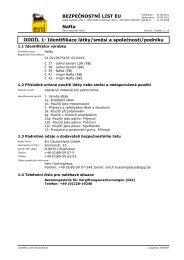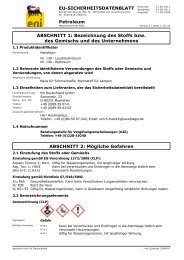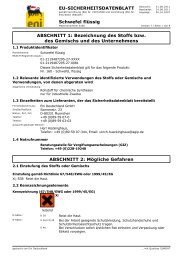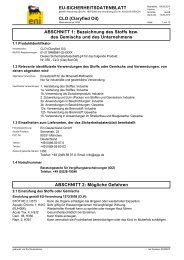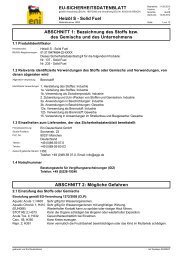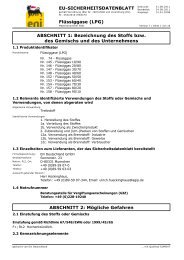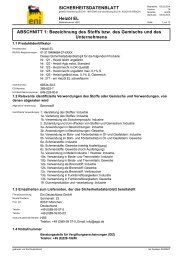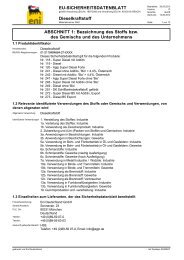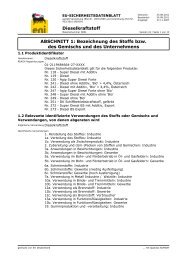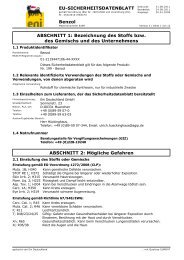EU-SICHERHEITSDATENBLATT Wachsdestillat (VGO) ABSCHNITT ...
EU-SICHERHEITSDATENBLATT Wachsdestillat (VGO) ABSCHNITT ...
EU-SICHERHEITSDATENBLATT Wachsdestillat (VGO) ABSCHNITT ...
Create successful ePaper yourself
Turn your PDF publications into a flip-book with our unique Google optimized e-Paper software.
Heavy Fuel Oil Componentsclosed loop or other system to avoid exposure E8. Wear chemicallyresistant gloves (tested to EN374) in combination with ‘basic’ employeetraining PPE16.CS85 Bulk product storage. Store substance within a closed system E84. Avoid carrying out activitiesinvolving exposure for more than 4 hours OC28. Wear chemicallyresistant gloves (tested to EN374) in combination with ‘basic’ employeetraining PPE16.CS137 Product sampling Sample via a closed loop or other system to avoid exposure E8. Avoidcarrying out activities involving exposure for more than 15 minutes OC26.Wear chemically resistant gloves (tested to EN374) in combination with‘basic’ employee training PPE16.CS36 Laboratory activities Handle within a fume cupboard or implement suitable equivalent methodsCS510_Marinevessel/barge (un)loadingCS511 Road tanker/RailcarloadingCS39 Equipment cleaningand maintenanceto minimise exposure E12. Wear suitable gloves tested to EN374 PPE15.Avoid carrying out activities involving exposure for more than 4 hoursOC28. Transfer via enclosed lines E52. Clear transfer lines prior to decouplingE39. Retain drain downs in sealed storage pending disposal orfor subsequent recycle ENVT4. Wear chemically resistant gloves (testedto EN374) in combination with ‘basic’ employee training PPE16.Ensure material transfers are under containment or extract ventilationE66. Wear chemically resistant gloves (tested to EN374) in combinationwith ‘basic’ employee training PPE16.Drain down and flush system prior to equipment break-in or maintenanceE55. Wear chemically resistant gloves (tested to EN374) in combinationwith specific activity training PPE17. Retain drain downs in sealed storagepending disposal or for subsequent recycle ENVT4.Additional information on the basis for the allocation of the identified OCs and RMMs iscontained in Appendices 2 to 3Section 2.2 Control of environmental exposureProduct characteristicsSubstance is complex UVCB [PrC3]. Predominantly hydrophobic [PrC4a].Amounts usedFraction of <strong>EU</strong> tonnage used in region 0.1Regional use tonnage (tonnes/year) 1.1e7Fraction of Regional tonnage used locally2.0e-3Annual site tonnage (tonnes/year) 2.3e4Maximum daily site tonnage (kg/day) 7.7e4Frequency and duration of useContinuous release [FD2].Emission days (days/year) 300Environmental factors not influenced by risk managementLocal freshwater dilution factor 10Local marine water dilution factor 100Other given operational conditions affecting environmental exposureRelease fraction to air from process (initial release prior to RMM)1.0e-4Release fraction to wastewater from process (initial release prior to 1.0e-7RMM)Release fraction to soil from process (initial release prior to RMM) 0.00001Technical conditions and measures at process level (source) to prevent releaseCommon practices vary across sites thus conservative process release estimates used [TCS1].Technical onsite conditions and measures to reduce or limit discharges, air emissions andreleases to soilRisk from environmental exposure is driven by humans via indirect exposure [TCR1j].No wastewater treatment required [TCR6].Treat air emission to provide a typical removal efficiency of (%) 90Treat onsite wastewater (prior to receiving water discharge) to provide 02010-08-10 CSR 128



